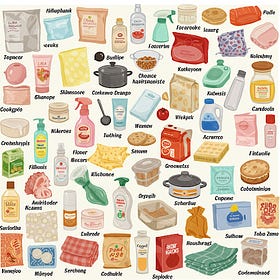What to Remove for a Low-Toxin Lifestyle: Your Workspace
Easy-to-Follow Lists for Every Area of Your Life
Your workspace can be a tricky area to keep non-toxic, depending on the environment. Thankfully, my coworkers are supportive of my “crunchy” habits! I brought in an air purifier to keep the air clean, a humidifier to help reduce germs, and we steer clear of air fresheners and plug-ins. (Because who needs artificial scents when you have the natural aroma of office coffee and stale microwave popcorn?) Plus, the cleaning crew avoids using harsh chemicals, which is a huge bonus. To take it a step further, I bring my own silverware and dishes to use during meals. Small adjustments can make a big difference in creating a healthier workspace!
To create a healthier workspace, consider removing these items:
Chemical Air Fresheners – Synthetic air fresheners release harmful VOCs into the air. Opt for essential oil diffusers or natural air purifiers.
Plastic Office Supplies – Many plastic supplies (binders, pens, folders) are made with harmful chemicals like BPA. Choose eco-friendly alternatives made from bamboo, glass, or recycled materials.
Toxic Office Furniture (PVC or treated wood) – Office furniture made from synthetic materials or treated with chemicals can off-gas harmful substances. Look for furniture made from natural wood or non-toxic materials.
Non-Stick Cookware in Break Rooms – If your workspace includes a break room or kitchenette, be cautious of non-stick pans and utensils that can release toxic chemicals. Switch to cast iron or stainless steel.
Bleach-based Cleaners – These can irritate your lungs and eyes, and may have long-term health effects. Replace with non-toxic, all-purpose cleaners made with natural ingredients like vinegar and baking soda.
Chemical-laden Hand Sanitizers – Many commercial hand sanitizers contain synthetic fragrances and alcohol. Look for alcohol-free, natural hand sanitizers with soothing ingredients like aloe vera.
Traditional Desk Clutter (Plastic) – Plastic items like organizers, decorations, and pens can contribute to indoor pollution. Replace with natural, eco-friendly alternatives like wooden or metal organizers.
Outdated Electronics – Old electronics may contain toxic materials such as mercury or lead. Recycle any outdated devices, and opt for more energy-efficient, modern models.
Pesticides or Insect Repellents – Many office spaces use chemical sprays for pests. Try using natural repellents such as essential oils (peppermint, eucalyptus) to avoid toxins.
Cigarette Smoke Residue – Smoke residue from cigarettes or cigars can linger in office furniture, carpets, and curtains. If you work in a building that allows smoking, ventilate regularly, or switch to non-toxic alternatives.
Toxic Printer Cartridges – Some printer cartridges release toxic fumes when used, particularly those with non-organic materials. Switch to eco-friendly toner and ink alternatives, and always recycle printer cartridges.
Excess Paper and Plastics – Unnecessary paper and plastic clutter can build up in your workspace. Minimize waste and switch to digital options, or opt for recycled paper products.
Fast Food Packaging – Take-out containers from fast food often contain harmful chemicals like BPA and phthalates. Bring your own lunch in reusable containers to avoid chemicals leaching into your food.
Scented Candles or Plug-ins – Many candles and plug-ins contain paraffin or phthalates, both of which release toxins when burned. Look for natural soy candles or beeswax alternatives.
Furniture Made with Flame Retardants – Many office chairs and couches contain flame-retardant chemicals linked to cancer and reproductive harm. Look for furniture that’s free from these additives.
Toxic Adhesives – Some glues, adhesives, and tapes contain chemicals that can off-gas toxic fumes. Opt for non-toxic, eco-friendly adhesive products.
Old, Harsh Cleaning Products – Items like harsh floor cleaners or window sprays may be filled with VOCs and ammonia. Replace them with non-toxic, natural cleaning options.
Excessive Synthetic Fabrics – Synthetic materials in upholstery, carpets, and curtains can emit harmful chemicals. Consider replacing them with natural fabric options made from cotton or linen.
Removing toxic items from your workspace not only enhances your well-being but can also help improve productivity and focus, creating a healthier environment for everyone. (And maybe even make Mondays a little less dreadful. Okay, maybe not.)
More to Explore
What to Remove for a Low-Toxin Lifestyle: Food
When I first began my wellness journey nearly 20 years ago, it all started with food—specifically, cutting out unnecessary ingredients lurking in everyday items. Over time, that focus expanded to the products we used in our home. The more I learned, the more changes I made. I swapped out fabrics, overhauled cookware, and revamped so many other aspects o…



